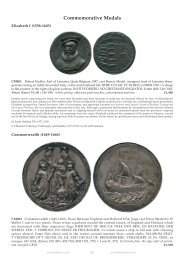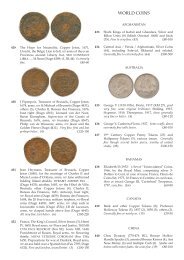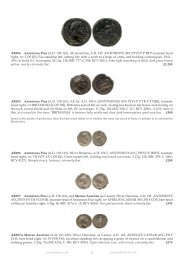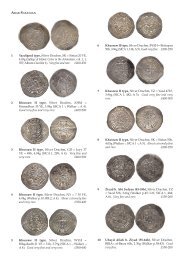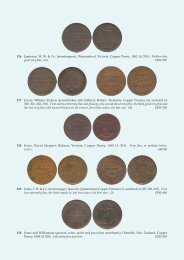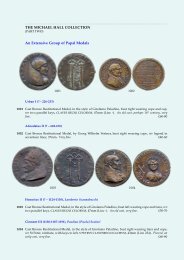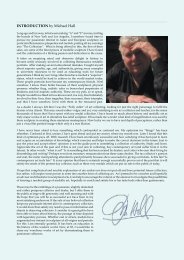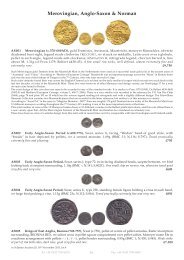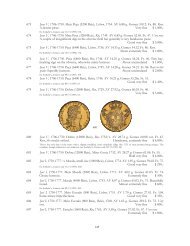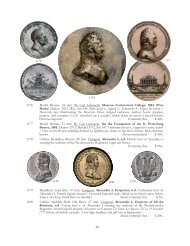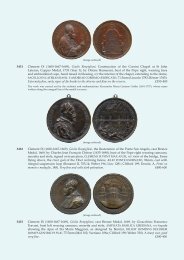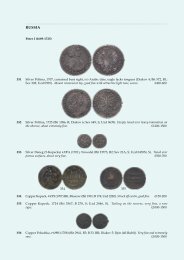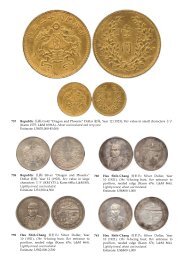The Prospero Collection - Part 05 - Baldwin's
The Prospero Collection - Part 05 - Baldwin's
The Prospero Collection - Part 05 - Baldwin's
You also want an ePaper? Increase the reach of your titles
YUMPU automatically turns print PDFs into web optimized ePapers that Google loves.
A 100 Litrai of Wonderful Style<br />
191 Sicily, Syracuse, Agathokles (317-289 B.C.), EL 100 Litrai, 6.51g, . Struck c.304-289 B.C. ΣYPAKOΣIΩN,<br />
laureate head of Apollo facing to left, a tripod behind. Rev. ΣΩTEIPA, head of Artemis facing to right,<br />
wearing a ribbon in her hair, an earring and a pearl necklace, with a quiver over her shoulder, a tripod<br />
behind (Jenkins, ‘Electrum Coinage at Syracuse’, in Essays to Robinson, Group D, pl. 15, 3 (these dies);<br />
SNG Lockett 992; Gulbenkian 344). Light crack in flan, very pretty style, attractively toned, extremely<br />
fine and rare. $ 40,000<br />
Ex Monnaies et Médailles, Auction 54, Basel, 26 October 1978, lot 132<br />
Ex Bank Leu AG, Auction 33, Zurich, 3 May 1983, lot 245<br />
192 Sicily, Syracuse, Hiketas (288-278 B.C.), Gold Dekadrachm, 4.24g, . ΣYPAKOΣIΩN, head of<br />
Persephone facing to left, wearing a wreath of barley and a pendant earring, a cornucopiae behind.<br />
Rev. Nike driving a galloping biga to right, a ring above, Θ below horses, EΠIIKETA in the exergue<br />
(T.V. Buttrey, ‘<strong>The</strong> Morgantina Gold Hoard and the Coinage of Hicetas’ NC 1973, p. 10, 4-G, pl. II;<br />
BMC 433; SNG ANS 777-8; Gulbenkian 345). Good very fine. $ 6,000<br />
Ex <strong>Collection</strong> of Ancient Greek Gold and Silver Coins formed by a Foreign Amateur, Glendining & Co., London,<br />
13 December 1963, lot 181
An Excessively Rare 32 Litrai<br />
193 Sicily, Syracuse, Hieron II (275-215 B.C.), Silver 32 Litrai, 27.68g, . Head of Hieron II facing to left,<br />
wearing a diadem, a stalk of barley (?) behind. Rev. BAΣIΛEOΣ / IEPΩNOΣ, Nike, as charioteer, driving<br />
a galloping quadriga to right, holding a kentron in her right hand and the reins in her left, small E below<br />
horses (BMC 524; W. Giesecke, Sicilia Numismatica, pl. 24, 7 (this reverse die); Antikenmuseum Basel<br />
531; McClean 29<strong>05</strong> var.; cf. Gulbenkian 353 (quadriga walking)). A very impressive coin of almost<br />
medallic proportions, excellent portrait, dark tone, very fine and excessively rare. $ 20,000
194 Sicily, Syracuse, Hieron II (275-215 B.C.), Silver Oktobol, 5.73g, . Head of Athena facing to left,<br />
wearing a crested Corinthian helmet decorated with a serpent, a symbol (spear-head?) behind. Rev.<br />
IEPΩNOY, Peagsos flying to right, Π below (SNG Lloyd 1541 var.; SNG ANS 868 var.). Lightly toned,<br />
extremely fine. $ 1,500<br />
Purchased from Spink & Son Ltd., London, 20 January 1988<br />
195 Sicily, Syracuse, Fifth Republic (214-212 B.C.), Silver 16 Litrai, 13.54g, . Laureate head of Zeus facing<br />
to left. Rev. ΣYPAKOΣIΩN, Nike, holding a whip and the reins, driving a galloping quadriga to right,<br />
Σ-Λ below horses, YA in exergue (A. Burnett, ‘<strong>The</strong> Enna Hoard and the silver coinage of the Syracusan<br />
Democracy’, SNR 62, 1983, pl. 8, D 4 (these dies); Jameson 889 (these dies); Boston 483 (these dies);<br />
Kraay - Hirmer pl. 51, 145 (these dies); BMC 650). A small die-flaw on neck, lightly toned, about<br />
extremely fine and rare. $ 12,000<br />
Ex Bank Leu AG, Auction 7, Zurich, 7 May 1973, lot 93<br />
Ex Bank Leu AG, Auction 50, Zurich, 25 April 1990, lot 74
196 Sicily, Syracuse, Fifth Republic (214-212 B.C.), Silver 12 Litrai, 10.10g, . Head of Athena facing<br />
to left, wearing a crested Corinthian helmet, an earring, necklace and an aegis. Rev. ΣYPAKOΣIΩN,<br />
Artemis standing facing to left, drawing a bow, a hound leaps to left at her feet, ΛY on left (Burnett,<br />
‘<strong>The</strong> Enna Hoard and the silver coinage of the Syracusan Democracy’, SNR 62, 1983, pl. 10, D35<br />
(these dies)). Extremely fine. $ 2,800<br />
Purchased from A.H. Baldwin & Sons Ltd., London, 4 November 1983<br />
SICULO-PUNIC<br />
197 Siculo-Punic, Panormos (c.425-300 B.C.), Silver Tetradrachm, 16.95g, . Struck c.4<strong>05</strong>-380 B.C.<br />
Charioteer, wearing a long chiton and holding a kentron and the reins, driving a galloping quadriga<br />
to right towards the meta (Ionic column), Nike flies above to left to crown the charioteer, a crayfish<br />
to right in the exergue. Rev. Head of Arethusa facing to right, wearing an earring and necklace, three<br />
dolphins (only two visible) swimming around (Jenkins, ‘Coins of Punic Sicily’, <strong>Part</strong> 1, SNR 50, 1971,<br />
23 (O5’/R21); BMC 5 (these dies); Antikenmuseum Basel 391 (these dies); SNG ANS -). Old cabinet<br />
tone, a little softly struck on high point, otherwise good very fine. $ 3,300<br />
Ex Jacques Schulman B.V., Auction 264, Amsterdam, 26 April 1976, lot 5043<br />
Ex Frank Sternberg, Auction XX, Zurich, 20 April 1988, lot 473<br />
Ex Jascha Heifetz <strong>Collection</strong>, <strong>Part</strong> 2, Superior Galleries, New York, 9 & 10 December 1989, lot 2406<br />
Purchased from Spink & Son Ltd., London, 6 April 1990
Queen Dido of Carthage<br />
198 Siculo-Punic (c.360 B.C.), Silver Tetradrachm, 17.28g, . Head of Queen Dido facing to left, wearing<br />
an Asiatic headdress, bound with a palmette-embroidered band. Rev. Lion walking to left, its head<br />
facing, behind which is a date-palm in fruit, the Punic inscription (ShAMMChNT) (the people of the<br />
camp) in the exergue (Jenkins, ‘Coins of Punic Sicily’, <strong>Part</strong> 3, SNR 56, 1977, 271 N (O84/R225) (this<br />
coin); Rizzo, pl. LXVI, 7 (these dies); B.V. Head, BM Principal Coins, pl. 26, 41 (these dies); Kraay<br />
- Hirmer pl. 72, 207 (these dies); Kraay, ACGC pl. 51, 876 (these dies)). Small flaw on the cheek,<br />
extremely fine, of the highest artistic style of the period, extremely rare, a masterpiece. $ 75,000<br />
This coin published in ‘Coins of Punic Sicily’, <strong>Part</strong> 3, G.K. Jenkins, SNR 56 (1977), p. 62, 271 N, illustrated on pl. 22.<br />
Ex Numismatic Fine Arts, Auction II, Beverly Hills, 25-26 March 1976, lot 80 (the obverse and reverse are both<br />
illustrated on the front and back covers of the catalogue)<br />
Ex Sotheby’s, London, 26-27 March 1987, lot 367<br />
This coin is struck from superbly engraved dies of the finest artistic style of the period and it is generally considered<br />
to be a true masterpiece of fourth century Sicilian numismatic art. It must be assumed that the die engraver was<br />
a Greek artist of the highest ability, rather than an invading Carthaginian. <strong>The</strong> types of the coin are however<br />
distinctly Carthaginian. <strong>The</strong> female head on the obverse of this beautiful coin has traditionally been identified as<br />
that of Dido, the founding Queen of Carthage, who had fled her homeland of Tyre after her brother Pygmalion<br />
had murdered her husband. <strong>The</strong> lion, symbolic of the Carthaginians’ African origin, appears on the reverse. This<br />
coin is incredibly rare, with only five examples recorded by Jenkins (Coins of Punic Sicily, <strong>Part</strong> 3, SNR 56, 1977,<br />
271, the other four are in national museums in Berlin, London, Paris and Syracuse. Another appeared in the Nelson<br />
Bunker Hunt <strong>Collection</strong>, Sotheby’s New York, 19 June 1990, lot 96).
Exceptional Classical Style<br />
199 Siculo-Punic (c.360 B.C.), Silver Tetradrachm, 17.04g, . Female head (Tanit / Dido?) facing to left,<br />
wearing an oriental tiara with a neck flap, long locks of curling hair flow out the side and behind. Rev.<br />
Punic inscription (S’MMHNT) in the exergue, a lion walking to left, its head facing, a palm-tree in the<br />
background (Jenkins, ‘Coins of Punic Sicily’, <strong>Part</strong> 3, SNR 56, 1977, 270 (O83/R224); Gulbenkian 376<br />
(these dies); SNG Lloyd 1628 (these dies); Rizzo pl. LXVI, 6 (these dies)). Of exceptional classical style,<br />
lightly toned, good very fine to nearly extremely fine. $ 35,000<br />
Purchased from Spink & Son Ltd., London, 6 December 1983
200 Siculo-Punic, ‘RSMLQRT’ (c.360-330 B.C.), Silver Tetradrachm, 17.03g, . Charioteer, wearing a long<br />
chiton and holding a kentron in his right hand and the reins in his left, driving a galloping quadriga to<br />
right, Nike flies above to left to crown the charioteer, Punic legend (RSMLQRT) (only partially visible)<br />
in the exergue. Rev. Head of Arethusa facing to right, wearing a wreath of grain-ears, a triple-pendant<br />
earring and a necklace, three dolphins swimming around her (Jenkins, ‘Coins of Punic Sicily’, <strong>Part</strong> I, SNR<br />
50, 1971, 37 (O14/R28); Jameson 597 (these dies); de Luynes 920 (these dies)). Well struck on a broad<br />
flan, outstanding iridescent cabinet tone, very good style, extremely fine. $ 5,000<br />
Purchased from Spink & Son Ltd., London<br />
201 Siculo-Punic, ‘RSMLQRT’ (c.360-330 B.C.), Silver Tetradrachm, 16.78g, . Charioteer, wearing a long<br />
chiton and holding a kentron in his right hand and the reins in his left, driving a galloping quadriga to<br />
right, Nike flies above to left to crown the charioteer, Punic legend (RSMLQRT) (only partially visible)<br />
in the exergue. Rev. Head of Arethusa facing to right, wearing a wreath of grain-ears, a triple-pendant<br />
earring and a necklace, four dolphins swimming around her (Jenkins, ‘Coins of Punic Sicily’, <strong>Part</strong> I, SNR<br />
50, 1971, 41 (O15/R32); I. Lee, ‘<strong>The</strong> Silver Coinage of the Campanian Mercenaries and the Site of the<br />
First Carthaginian Mint 410-409 B.C.’, NC 2000, p. 42-3, 57; BMC 7; Gulbenkian 203 (these dies); SNG<br />
Lockett 744). Cabinet tone, nearly extremely fine and rare. $ 3,250<br />
Purchased from Spink & Son Ltd., London, 23 August 1984
202 Siculo-Punic, Entella (c.345-315 B.C.), Silver Tetradrachm, 16.62g, . Head of Arethusa facing to<br />
left, wearing a wreath of grain ears, a triple-pendant earring and a necklace, a small shell below her<br />
chin, four dolphins swimming around. Rev. Horse standing to right on a thick ground line, raising its<br />
right foreleg, a palm-tree in the background (Jenkins, ‘Coins of Punic Sicily’, <strong>Part</strong> 3, SNR 56, 1977,<br />
134 (O45/R120’); Nanteuil 411 (these dies)). Struck from beautiful dies of superb style, cabinet<br />
tone, extremely fine and rare. $ 8,000<br />
Ex Monnaies et Médailles SA, Auction 43, Basel, 12 & 13 November 1970, lot 23<br />
203 Siculo-Punic (c.330 B.C.), Silver Tetradrachm, 17.10g, . Head of Tanit-Persephone facing to left,<br />
wearing a barley-wreath, a triple-pendant earring and a necklace, four dolphins swimming around.<br />
Rev. Horse standing to right, a palm-tree in the background, a crescent above on left, a poppy on the<br />
exergual line (Jenkins, ‘Coins of Punic Sicily’, <strong>Part</strong> 3, SNR 56, 1977, 119 (O39/R108); SNG Lloyd 1618<br />
(these dies)). Very attractive style, the work of a talented artist, lightly toned over residual lustre, a small<br />
mark on cheek, about extremely fine. $ 15,000<br />
Purchased from Spink & Son Ltd., London, 30 October 1985
Beautiful Style<br />
204 Siculo-Punic (c.320 B.C.), Silver Tetradrachm, 17.15g, . Head of Tanit-Persephone facing to left, wearing<br />
a wreath of barley, a triple-pendant earring and a necklace. Rev. Horse rearing to right, a palm-tree in the<br />
background (Jenkins, ‘Coins of Punic Sicily’, <strong>Part</strong> 3, SNR 56, 1977, 126 (O42/R114); Gulbenkian 363<br />
(these dies); de Luynes 1422 (these dies)). Very attractive style, extremely fine. $ 17,500<br />
Ex Numismatic Fine Arts, Auction XII, Beverly Hills, 23 & 24 March 1983, lot 34<br />
Ex Numismatic Fine Arts, Auction XXII, Beverly Hills, 1 June 1989, lot 226
A Highly Regarded Siculo-Punic Rarity<br />
2<strong>05</strong> Siculo-Punic, Machanat (c.320-315 B.C.), Silver Tetradrachm, 17.13g, . Female head (Tanit /<br />
Dido?) facing to right, wearing a Phrygian tiara, with stiff radiating pleats, a helmet-like vizor<br />
and a long neck flap, a few long locks of hair flowing out behind, and wearing an earring. Rev.<br />
Punic inscription (S’MMHNT) in exergue, lion prowling to right, its head facing, a palm-tree in the<br />
background (Jenkins, ‘Coins of Punic Sicily’, <strong>Part</strong> 3, SNR 56, 1977, 272 (O85/R226); Rizzo pl.<br />
LXVI, 8 (these dies); Antikenmuseum Basel 562 (these dies); Kraay – Hirmer pl. 73, 208 (these dies)).<br />
Lightly toned, about extremely fine, rare. $ 40,000<br />
Ex Numismatik Lanz, Auction 30, Munich, 26 November 1984, lot 119
206 Siculo-Punic, Entella (c.320-300 B.C.), Silver Tetradrachm, 16.95g, . Head of Arethusa facing to left,<br />
wearing a wreath of grain-ears, a triple-pendant earring and a necklace, four dolphins swimming around.<br />
Rev. Horse’s head facing to left, a palm-tree behind, Punic legend (‘MMHNT) below (Jenkins, ‘Coins of<br />
Punic Sicily’, <strong>Part</strong> 3, SNR 56, 1977, 169 (O50/R150)). Well-struck in high relief, extremely fine, a scarce<br />
die combination. $ 14,000
207 Siculo-Punic (c.300 B.C.), Silver Tetradrachm, 16.38g, . Head of young Herakles facing to right, wearing<br />
a lion’s skin headdress. Rev. Horse’s head facing to left, a kerykeion before, a palm-tree behind, Punic<br />
legend (‘mhsbm) below horse’s neck (Jenkins, ‘Coins of Punic Sicily’, <strong>Part</strong> 4, SNR 57, 1978, 349 (O112/<br />
R283)). Extremely fine, a very good example. $ 7,000
A Dekadrachm from the Time of <strong>The</strong> First Punic War<br />
208 Siculo-Punic (Time of the First Punic War, c.264-260 B.C.), Silver Dekadrachm or 5 Shekels, 37.92g, .<br />
Mint of Carthage. Head of Tanit-Persephone facing to left, wearing a grain-wreath and a pendant<br />
earring. Rev. Pegasos flying to right, Punic legend (B’RST) below (Jenkins, ‘Coins of Punic Sicily’, <strong>Part</strong> 4,<br />
SNR 57, 1978, 435 (OI’/R5), pl. 17 (this coin); Antikenmuseum Basel 567; SNG Lloyd 1665; Kraay<br />
– Hirmer pl. 74, 211). Attractively toned, nearly extremely fine. $ 30,000<br />
This coin published in ‘Coins of Punic Sicily’, <strong>Part</strong> 4, G.K. Jenkins, SNR 57, 1978, p. 41, 435, illustrated on pl. 17.<br />
From the Palermo Hoard of 1958<br />
Purchased from Spink & Son Ltd., London, 20 February 1984
An Extremely Rare Shekel of Carthage<br />
From the Time of <strong>The</strong> Second Punic War<br />
209 Siculo-Punic (Second Punic War Issue, c.213-210 B.C.), Silver Shekel, 6.89g, . Struck at Carthage.<br />
Male head facing to left (Melqart? / Hannibal?). Rev. Elephant walking to right, Punic A(leph) in the<br />
exergue (A. Burnett, ‘<strong>The</strong> Enna Hoard and the silver coinage of the Syracusan Democracy’, SNR 62,<br />
1983, 114-5; E.S.G. Robinson, ‘Punic Coins of Spain and their bearing on the Roman Republican<br />
Series’, Essays to Mattingly, series 8a, pl. III (Gades?); SNG Copenhagen 382 (uncertain African<br />
or Sicilian mint)). Attractive light toning, good extremely fine and extremely rare, only a few known<br />
specimens of which this is perhaps the finest. $ 35,000<br />
Ex Numismatic Fine Arts, Auction XIV, New York, 29 November 1984, lot 75<br />
This issue has traditionally been attributed to a Spanish mint. However, more recent Sicilian hoard evidence<br />
suggests that it was struck in Carthage at the time of the Second Punic War. <strong>The</strong>re were only two specimens<br />
recorded in the Enna hoard and the shekel is still an extremely rare coin.<br />
It has been suggested that the head on the obverse of the coin might be that of Hannibal, in the guise of Melqart,<br />
or of another Punic ruler. In the absence of firm evidence, this theory can only be conjectural, and the head is<br />
usually identified as that of Melqart. <strong>The</strong> features of the head, with the raised brow, the distinct bridge of the nose,<br />
the prominent chin, and the sideburns, does perhaps suggest a realism that one would expect from portraiture. <strong>The</strong><br />
reverse of the coin depicts one of the Carthaginian War elephants that would have been used by Hannibal to cross<br />
the Alps in his campaign against Rome.
210 <strong>The</strong> Barcids in Spain, <strong>The</strong> Carthaginian Occupation of Gades (c.237-209 B.C.), Silver Shekel,<br />
7.17g, . Struck at Carthago Nova. Male head (Hamilcar?) facing to left, wearing a diadem. Rev.<br />
Prow of a galley to right, with a shield on its deck, a dolphin below to right (SNG BM Spain<br />
91; Villaronga, MHC 19; E. Robinson, ‘Punic Coins of Spain and their bearing on the Roman<br />
Republican Series’, in Essays in Roman Coinage presented to Harold Mattingly (1956), 49, 4c;<br />
Villaronga, CNH p. 64, 10; SNG Copenhagen Supplement 1332). Lightly toned, extremely fine, one<br />
of the finest known specimens of this very rare coin. $ 10,000<br />
Ex Numismatik Lanz, Auction 20, Munich, 13 April 1981, lot 159 (illustrated on the front and back covers of<br />
the catalogue)<br />
Ex Monnaies et Médailles SA, Auction 66, Basel, 22-23 October 1984, lot 1<br />
Hamilcar Barca had been the commander of the Carthaginian fleet during the First Punic War. He was forced<br />
to withdraw to Africa after suffering a defeat at the hands of the Roman forces in 241 B.C. and agreed to terms<br />
which made him abandon claims to Sicily and Sardinia. Hamilcar soon made an alternative attempt to expand into<br />
Spain, together with his son Hannibal, where he based himself at Gades (Cádiz). He eventually died in battle in<br />
229 B.C.
THE BLACK SEA,<br />
THRACE<br />
AND<br />
MACEDONIA
BLACK SEA REGION<br />
An Incredibly Rare Didrachm of Kolchis<br />
Of Exceptional Archaic Style<br />
211 Black Sea Region, Kolchis (late 5 th – early 4 th century B.C.), Silver Didrachm, 9.33g, . Head of Artemis<br />
Dali facing to right, her hair flowing down her neck. Rev. Two female heads facing inwards towards each<br />
other, each within an incuse square (SNG BMC Black Sea 1012 (this obverse die); Jameson 2543). A few<br />
pits, toned, very fine, of fantastic archaic style, incredibly rare, this example being in perhaps the finest state of<br />
preservation, a fascinating and highly important coin. $ 95,000<br />
Purchased from Spink & Son Ltd., London, 22 January 1988<br />
Kolchis was situated on the eastern coast of the Black Sea at the foot of the Caucasus mountains. In ancient times,<br />
it was the mythological destination of Jason and the Argonauts’ quest to retrieve the Golden Fleece. <strong>The</strong> king of<br />
Kolchis, Aeëtes, promised to let Jason have the fleece if he could first perform three tasks. While he was carrying<br />
out his tasks, Aphrodite had caused Medea, the daughter of king Aeëtes, to fall in love with Jason, and she helped<br />
him to succeed in his quest. <strong>The</strong> first task was to plow a field with fire-breathing oxen, in which Medea aided Jason<br />
by providing him with ointment to protect him from the flames. <strong>The</strong> second task was to sow the teeth of a dragon<br />
that sprouted into an army of warriors which Jason had to overcome. Again Medea helped him by advising him to<br />
throw a rock into the crowd of warriors that caused them to attack each other rather than Jason. His last task was<br />
to defeat the sleepless dragon which guarded the golden fleece, and Medea caused the dragon to sleep while Jason<br />
retrieved the fleece. He and Medea then fled to Corinth, where they lived together until Jason became engaged to<br />
Kreusa, the daughter of Kreon. Medea was so angered by this betrayal that she took her revenge by killing the two<br />
sons she bore to Jason, as well as his new bride.<br />
It would be almost overwhelmingly tempting to associate the two archaic heads on the reverse of this coin with<br />
those of Jason and Medea. However, they do appear both to be female in appearance and, in the absence of any<br />
evidence, their identity remains unknown.
212 Black Sea Region, Pantikapaion (c.450-420 B.C.), Silver Didrachm, 7.45g, . Lion’s head facing. Rev.<br />
Incuse square, the letters Π-A-N and a four-rayed star on four quarters (Jameson 1360 = Babelon, Traité<br />
IV, pl. CCCLIII, 5; SNG BM Black Sea -; SNG Stancomb -). Good very fine, rare. $ 1,500<br />
Ex Monnaies et Médailles SA, Auction 64, Basel, 30 January 1984, lot 57
<strong>The</strong> Facing Head Gold Stater of Pantikapaion<br />
One of the Greatest Masterpieces of Ancient Coinage<br />
213 Black Sea Region, Pantikapaion (c.350-300 B.C.), Gold Stater, 9.12g, . Head of bearded satyr facing,<br />
inclined slightly to the left, with long dishevelled hair and pointed horse’s ear. Rev. Π-A-N, winged griffin<br />
standing to left, with its horned head facing, its right forepaw raised, holding a spear in its jaws, a<br />
large grain-ear below on which the griffin stands (Locker Lampson 122 (ex Grand Duke Alexander<br />
Mikhailovich collection) = Gulbenkian 583 (these dies); Gulbenkian 584 (this obverse die), 580 (this<br />
reverse die); K. Regling, ‘Der Griechische Goldschatz von Prinkipo’, ZfN XLI, 1931, 165 (this obverse<br />
die); BM Principal Coins III. B, 1, pl. 21, 1; Jameson 2143). One small area of softness at top of the<br />
head, otherwise well-struck and extremely fine, fantastic style, one of the greatest and most admired of all<br />
ancient Greek coins, a true masterpiece and incredibly rare, a coin of the highest importance. $ 650,000<br />
Purchased from Bank Leu Ltd., Zurich, 1991<br />
<strong>The</strong> facing head Pantikapaion gold stater, among the most spectacular numismatic objects to survive from the classical<br />
world, is one of the greatest pinnacles of ancient Greek numismatic art. <strong>The</strong> opportunity to acquire an example is<br />
seldom encountered by numismatists. Godfrey Locker Lampson, whose example was struck from the same dies as<br />
this coin, provides us with his own inspired account of the obverse: “<strong>The</strong> head of the satyr is a marvel of speaking<br />
portraiture. That so much expression could be packed into so small a round would not be believed by any one who<br />
had not seen it....If a single coin had to be selected from those described in these pages, as by the greatest of all dieengravers,<br />
whoever he may have been, whose work had lasted to the present day, the writer would choose this one.<br />
Its creator has left no name behind him, but none but a consummate artist of remarkable and original genius could<br />
have produced this unforgettable and amazing little gem.” (Locker Lampson <strong>Collection</strong> (foreword, p. vii)).<br />
<strong>The</strong> example from the Locker Lampson <strong>Collection</strong> is now in the Gulbenkian <strong>Collection</strong>, where it resides together<br />
with two other similar examples, one of which shares the same obverse die.<br />
<strong>The</strong> Greek colony of Pantikapaion was founded in the seventh century B.C. by the Milesians and, by the fourth<br />
century, the city had amassed considerable wealth through its exports of grain. <strong>The</strong> griffin on the reverse of this<br />
coin is seen standing upon a grain-ear, symbolic of its importance to the financial well-being of the city. <strong>The</strong> issue<br />
of gold staters, this three-quarter facing head example being one of the most important, was a manifestation of<br />
the wealth of Pantikapaion.
A Spectacular Profile Head Gold Stater of Pantikapaion<br />
214 Black Sea Region, Pantikapaion (c.340-325 B.C.), Gold Stater, 9.10g, . Head of bearded Pan, with<br />
a goat’s ear, facing to left, wearing an ivy-wreath. Rev. Π-A-N, winged griffin, standing to left, with<br />
its horned head facing, holding a spear in its jaws, its right forepaw raised, a large stalk of wheat<br />
below on which the griffin stands (Anokhin 109; SNG BM Black Sea 867; Kraay - Hirmer pl. 142,<br />
440; Gulbenkian 589). A spectacular type of great beauty, lustrous, extremely fine, one of the most<br />
desirable of all ancient Greek gold coins. $ 55,000<br />
Purchased from Spink & Son Ltd., London, 22 April 1986<br />
This superb coin is one of the most admired of all ancient Greek gold issues. <strong>The</strong> head of Pan on the obverse<br />
possesses great power and beauty. <strong>The</strong> griffin on the reverse, the fabled guardian of the gold mines of the<br />
Scythians, is a fitting mythical beast to feature on this gold coin. Pantikapaion used gold that originated from the<br />
steppes in the East and with it came the romantic tale of the griffin which, to contemporary individuals, may have<br />
seemed to be a living creature. <strong>The</strong> gold was mined in the area in central Asia where modern-day palaeontologists<br />
have discovered fossils of the beaked dinosaur, Protoceratops. This dinosaur was about the size of a lion and had a<br />
head not dissimilar to that of an eagle. It seems plausible that the Scythians could have discovered a Protoceratops<br />
fossil during the mining process and this gave rise to the story that this beast was a guardian of the remote sources<br />
of gold found there.
215 Black Sea Region, Tyra (c.350-300 B.C.), Silver Drachm, 5.79g, , Head of Demeter facing, inclined<br />
slightly to left, wearing a veil and ears of corn in her hair. Rev. TYPANON, a bull charging to left, its head<br />
lowered (SNG BM Black Sea 334; SNG Stancomb 329 (this reverse die); McClean 4313). Good very<br />
fine, very rare. $ 5,500<br />
216 Moesia, Istros (c.400-350 B.C.), Silver Drachm, 5.44g . Two young male heads facing side-by-side,<br />
the left one inverted. Rev. IΣTPIH, a sea-eagle standing to left on a dolphin, attacking it with its beak,<br />
a monogram below (SNG BM Black Sea 253; SNG Stancomb 149; AMNG I, 421). Traces of doublestriking<br />
on the reverse, otherwise sharply struck, cabinet tone, extremely fine. $ 950<br />
Ex Tkalec & Rauch, 15-16 April 1985, lot 44
An Extremely Rare Stater of Eminakos<br />
217 Skythia, Olbia, Dynast Eminakos (c.450-425 B.C.), Silver Stater, 11.50g. [EMINAK]O, Herakles, naked<br />
and wearing a lion’s skin headdress, kneeling to right, stringing a bow. Rev. Four-spoked studded<br />
wheel of ‘solar-disk’ design, four dolphins swimming around, all within an incuse square (SNG BM<br />
Black Sea 358; G.F. Hill, ‘Greek Coins Acquired by <strong>The</strong> British Museum’, NC 1926, p. 117, pl. V, 2;<br />
SNG Stancomb 342; Rosen 147; Jameson 2536; ‘Kunstfreund’, lot 46). Some light porosity, excellent<br />
transitional style, dark old tone, good very fine, very rare. $ 30,000<br />
Ex Frank Sternberg, Auction XXIV, 19 & 20 November 1990, lot 29<br />
<strong>The</strong> name ‘Eminakos’, apart from its appearance on this very rare issue, is otherwise unknown and it is assumed<br />
that it must refer to a Skythian dynast.
THRACE<br />
An Extremely Rare Oktodrachm of Abdera<br />
218 Thrace, Abdera (c.520/15-492 B.C), Silver Oktodrachm, 29.60g. Magistrate Anti.... ANTI, griffin, with<br />
curved wing and raising its right foreleg, seated facing to left on a base, a large pellet in the field to left<br />
and right. Rev. Quadripartite incuse square (May 52 (A.44 – recut to include the pellets / unlisted reverse<br />
die); Boston 745; Regling, Warren, 434; AMNG II, 2). Some light marks, toned, wonderful style, very<br />
fine, extremely rare, perhaps the only known specimen of this variety. $ 12,000<br />
Ex Giessener Münzhandlung, Auction 38, Munich, 30 November 1987, lot 96<br />
Ex Giessener Münzhandlung, Auction 42, Munich, 11 October 1988, lot 125<br />
Purchased from Spink & Son Ltd., London, 6 October 1989
219 Thrace, Abdera (c.492-473/0 B.C.), Silver Tetradrachm, 14.80g. AΣΓ-A, griffin facing to left, its forelegs<br />
and wings raised as if it is about to take flight. Rev. Incuse square, divided into quarters by two lines<br />
(May 60, unlisted dies); AMNG II, 17). Well-struck, lightly toned, about extremely fine, exceedingly rare,<br />
only one example recorded by May. $ 12,500<br />
220 Thrace, Abdera (c.473/0-449/8 B.C.), Silver Tetradrachm, 14.97g, . Magistrate Kallidamas. KA-<br />
ΛΛ-IΔA-MAΣ, Griffin seated facing to left, raising its right foreleg, a tunny below. Rev. ABΔ/HP/<br />
ITE/ΩN, around a quadripartite linear square, all within a shallow incuse square (May 146d (A120/<br />
P119) (this coin); AMNG II, 61; BMC 20; Kraay – Hirmer pl. 138, 427). Magnificent style and an<br />
excellent example of the transition between late archaic and early classical art, cabinet tone, good<br />
very fine, with a distinguished pedigree. $ 15,000<br />
This coin published in ‘<strong>The</strong> Coinage of Abdera’, J.M.F. May (1966), p. 129, 146d.<br />
Ex Trist <strong>Collection</strong><br />
Ex Frank Sherman Benson <strong>Collection</strong>, Sotheby’s, London, 3 - 11 February 1909, lot 448<br />
Ex H. Gordon Bois, Esq. <strong>Collection</strong>, Sotheby’s, London, 7 July 1947, lot 174<br />
Ex Monnaies et Médailles SA, Auction 64, Basel, 30 January 1984, lot 61 (illustrated on the front cover of the catalogue)
221 Thrace, Abdera (c.473/0-449/8 B.C.), Silver Tetradrachm, 15.07g, . Griffin, with its wings and its<br />
right foreleg raised, advancing to left on a base, a star of eight rays, with a dot between each, on left.<br />
Rev. EΠIMA-NΔPΩ-NAK-TOΣ around a raised square divided by two lines into quarters, all within an<br />
incuse square (May 182 (A.146/P.152), pl. XII (this coin); Nomisma III, pl. 2, 5 (this coin); AMNG II,<br />
54/2, pl. II, 15 (this coin)). Cabinet toning, good very fine, very rare and with an old pedigree. $ 9,000<br />
This coin published in ‘<strong>The</strong> Coinage of Abdera’, J.M.F. May (1966), p. 138, 182, illustrated on pl. XII; and in<br />
Nomisma III, illustrated on pl. 2, 5; and in AMNG II, 54/2, illustrated on pl. II, 15.<br />
Ex A. Rhousopoulos <strong>Collection</strong>, Jacob Hirsch, Auction XIII, Munich, 15 May 19<strong>05</strong>, lot 516
222 Thrace, Abdera (c.411/10-386/5 B.C.), Silver Stater, 12.84g, . ABΔH, griffin facing to left, its forelegs<br />
and wings raised as if about to spring from a base. Rev. HPA/ΓO/PH/Σ, head of Jason facing to right,<br />
wearing a petasos with the ties below his chin (May 273 (A.204/P.231); AMNG II, 94, pl. II, 26). Of<br />
refined style, good very fine and very rare. $ 1,500<br />
Ex Giessener Münzhandlung, Auction 52, Munich, 6 November 1990, lot 120<br />
223 Thrace, Abdera (c.411/10-386/5 B.C.), Silver Stater, 12.78g, . Griffin facing to left, its forelegs and<br />
wings raised as if about to spring from a base. Rev. Δ-I-ONY-Σ-AΣ, bearded head of Dionysos facing<br />
to right, wearing a wreath of ivy with berries above his forehead, all within a shallow incuse square<br />
(May 292 (A.215/P.247) = E.S.G. Robinson, ‘A Find of Coins of Thasos’, NC 1934, 2, pl. IV (these<br />
dies)). Nearly extremely fine and rare. $ 2,800
224 Thrace, Abdera (c.411/10-386/5 B.C.), Silver Stater, 12.90g, . ABΔHPITEΩN, griffin, with curved<br />
wings, seated facing to left, raising its right foreleg. Rev. EΠI MOΛ/ΠAΓOPEΩ, dancing girl to right, in<br />
action, wearing a short chiton and a polos, and raising her left arm, all within a shallow incuse square<br />
(May 313 (A.228/P.266) (these dies); Babelon, Traité, pl. CCCXXXV, 15). Excellent style, nearly<br />
extremely fine and very rare. $ 6,250<br />
Purchased from B.A. Seaby Ltd., London, 22 February 1989<br />
225 Thrace, Abdera (c.411/10-386/5 B.C.), Silver Stater, 12.88g, . Griffin facing to left, its forelegs and<br />
wings raised as if about to spring from a base. Rev. ΠPO-MH-ΘIΔ-HΣ, within a double linear frame<br />
enclosing a dolphin swimming diagonally downwards to right, all within a shallow incuse square<br />
(May 343 (unlisted obverse die / P.289); Jameson 1036 var.). Apparently an unrecorded variety with the<br />
obverse legend lacking, lightly toned, good very fine. $ 3,000<br />
Ex Giessener Münzhandlung, Auction 52, Munich, 6 November 1990, lot 125
Abdera Stater of Superb Style<br />
226 Thrace, Abdera (c.411/10-386/5 B.C.), Silver Stater, 12.83g, . ABΔH, griffin seated to left, its wings<br />
slightly spread, a cicada on left. Rev. EΠIΦIΛA / ΔOΣ, Herakles seated facing three-quarters to left<br />
on a rock draped with a lion’s skin, his torso and head turned facing, he holds a club in his right<br />
hand that rests on his right knee, and he rests his left elbow on his thigh, all within a shallow incuse<br />
square (May 396 (A277/P322); AMNG II, 1<strong>05</strong>, pl. II, 40; SNG Lockett 1132 (this obverse die);<br />
Gulbenkian 447 (this reverse die)). Struck from dies of superior artistic quality and style, lightly<br />
toned, nearly extremely fine. $ 9,000<br />
Purchased from Spink & Son Ltd., London, 20 February 1989<br />
<strong>The</strong> figure of Herakles on the reverse of this coin is considered to be one of the finest depictions of him in Greek<br />
coinage. <strong>The</strong> composition, although showing him at rest, clearly illustrates his power and strength. <strong>The</strong> griffin on<br />
the obverse is shown as if it is at the moment of landing, as its wings are slightly open giving the impression that<br />
they are still lightly fluttering. This stater of Abdera is one of the finest engraved of that series.



